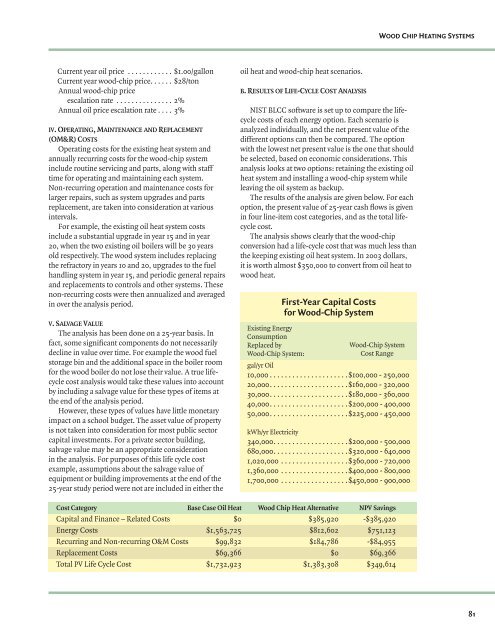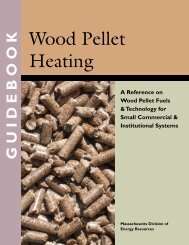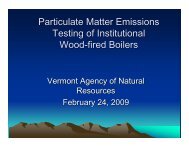Wood-Chip Heating Systems - Biomass Energy Resource Center
Wood-Chip Heating Systems - Biomass Energy Resource Center
Wood-Chip Heating Systems - Biomass Energy Resource Center
Create successful ePaper yourself
Turn your PDF publications into a flip-book with our unique Google optimized e-Paper software.
Current year oil price . . . . . . . . . . . . $1.00/gallon<br />
Current year wood-chip price . . . . . . $28/ton<br />
Annual wood-chip price<br />
escalation rate . . . . . . . . . . . . . . . 2%<br />
Annual oil price escalation rate . . . . 3%<br />
IV. OPERATING, MAINTENANCE AND REPLACEMENT<br />
(OM&R) COSTS<br />
Operating costs for the existing heat system and<br />
annually recurring costs for the wood-chip system<br />
include routine servicing and parts, along with staff<br />
time for operating and maintaining each system.<br />
Non-recurring operation and maintenance costs for<br />
larger repairs, such as system upgrades and parts<br />
replacement, are taken into consideration at various<br />
intervals.<br />
For example, the existing oil heat system costs<br />
include a substantial upgrade in year 15 and in year<br />
20, when the two existing oil boilers will be 30 years<br />
old respectively. The wood system includes replacing<br />
the refractory in years 10 and 20, upgrades to the fuel<br />
handling system in year 15, and periodic general repairs<br />
and replacements to controls and other systems. These<br />
non-recurring costs were then annualized and averaged<br />
in over the analysis period.<br />
V. SALVAGE VALUE<br />
The analysis has been done on a 25-year basis. In<br />
fact, some signifi cant components do not necessarily<br />
decline in value over time. For example the wood fuel<br />
storage bin and the additional space in the boiler room<br />
for the wood boiler do not lose their value. A true lifecycle<br />
cost analysis would take these values into account<br />
by including a salvage value for these types of items at<br />
the end of the analysis period.<br />
However, these types of values have little monetary<br />
impact on a school budget. The asset value of property<br />
is not taken into consideration for most public sector<br />
capital investments. For a private sector building,<br />
salvage value may be an appropriate consideration<br />
in the analysis. For purposes of this life cycle cost<br />
example, assumptions about the salvage value of<br />
equipment or building improvements at the end of the<br />
25-year study period were not are included in either the<br />
oil heat and wood-chip heat scenarios.<br />
B. RESULTS OF LIFE-CYCLE COST ANALYSIS<br />
NIST BLCC software is set up to compare the lifecycle<br />
costs of each energy option. Each scenario is<br />
analyzed individually, and the net present value of the<br />
different options can then be compared. The option<br />
with the lowest net present value is the one that should<br />
be selected, based on economic considerations. This<br />
analysis looks at two options: retaining the existing oil<br />
heat system and installing a wood-chip system while<br />
leaving the oil system as backup.<br />
The results of the analysis are given below. For each<br />
option, the present value of 25-year cash fl ows is given<br />
in four line-item cost categories, and as the total lifecycle<br />
cost.<br />
The analysis shows clearly that the wood-chip<br />
conversion had a life-cycle cost that was much less than<br />
the keeping existing oil heat system. In 2003 dollars,<br />
it is worth almost $350,000 to convert from oil heat to<br />
wood heat.<br />
Existing <strong>Energy</strong><br />
Consumption<br />
Replaced by<br />
<strong>Wood</strong>-<strong>Chip</strong> System:<br />
First-Year Capital Costs<br />
for <strong>Wood</strong>-<strong>Chip</strong> System<br />
<strong>Wood</strong>-<strong>Chip</strong> System<br />
Cost Range<br />
gal/yr Oil<br />
10,000 . . . . . . . . . . . . . . . . . . . . .$100,000 - 250,000<br />
20,000 . . . . . . . . . . . . . . . . . . . . .$160,000 - 320,000<br />
30,000 . . . . . . . . . . . . . . . . . . . . .$180,000 - 360,000<br />
40,000 . . . . . . . . . . . . . . . . . . . . .$200,000 - 400,000<br />
50,000 . . . . . . . . . . . . . . . . . . . . .$225,000 - 450,000<br />
kWh/yr Electricity<br />
340,000 . . . . . . . . . . . . . . . . . . . .$200,000 - 500,000<br />
680,000 . . . . . . . . . . . . . . . . . . . .$320,000 - 640,000<br />
1,020,000 . . . . . . . . . . . . . . . . . .$360,000 - 720,000<br />
1,360,000 . . . . . . . . . . . . . . . . . .$400,000 - 800,000<br />
1,700,000 . . . . . . . . . . . . . . . . . .$450,000 - 900,000<br />
Cost Category Base Case Oil Heat <strong>Wood</strong> <strong>Chip</strong> Heat Alternative NPV Savings<br />
Capital and Finance – Related Costs $0 $385,920 -$385,920<br />
<strong>Energy</strong> Costs $1,563,725 $812,602 $751,123<br />
Recurring and Non-recurring O&M Costs $99,832 $184,786 -$84,955<br />
Replacement Costs $69,366 $0 $69,366<br />
Total PV Life Cycle Cost $1,732,923 $1,383,308 $349,614<br />
WOOD CHIP HEATING SYSTEMS<br />
81





